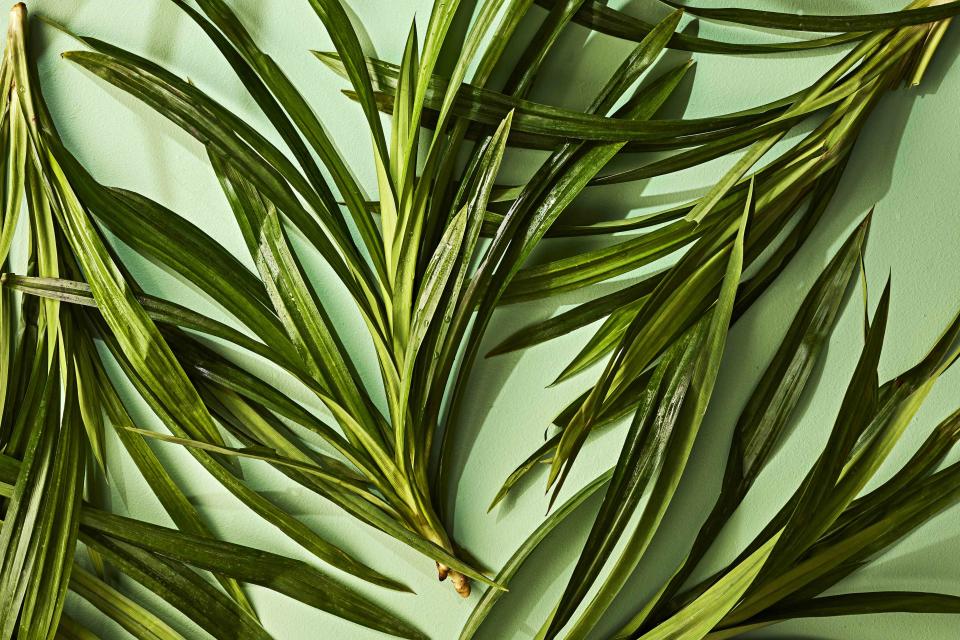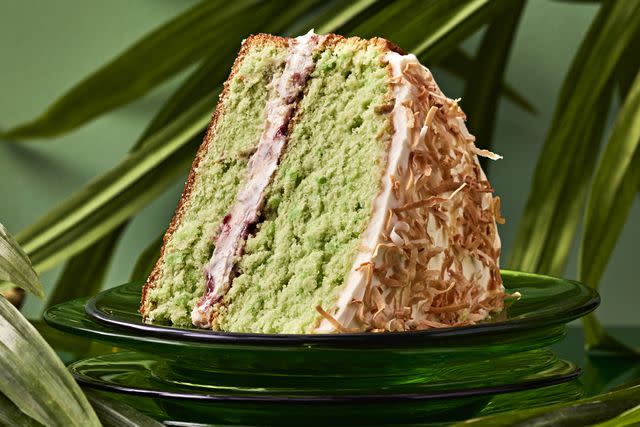A Guide to Cooking With Pandan, the Beloved Southeast Asian Ingredient
This leaf adds a heady fragrance and vibrant green hue to dishes from cakes to curries.

Victor Protasio / Food Styling by Julian Hensarling / Prop Styling by Claire Spollen
Pandan is Southeast Asia’s aromatic, enigmatic green muse. The flowering tropical plant thrives in the region and is so abundant that if not for its culinary significance, it might be considered a weed.
There are hundreds of species of pandan, but only the leaves of Pandanus amaryllifolius exude a tantalizing fragrance. The scent of its elongated, spearlike, glossy deep-green blades is elusive, but envision the melding of toasted rice, freshly mown grass, and sweet blooming jasmine, and you’ll begin to get the idea.
In savory dishes, pandan amplifies sweetness, bringing a unique depth of flavor. In Singapore and Malaysia, pandan leaves are simmered in coconut milk to produce the rich, fragrant coconut rice pivotal to nasi lemak (coconut rice topped with fried anchovies and peanuts). In Indonesia, pandan joins forces with turmeric to make nasi kuning (turmeric rice).
The realm of pandan-tinted sweets is even more vast and varied. There’s the honeycomb-textured Vietnamese cake bánh bò nuóng, and Singapore’s ethereal pandan chiffon cake that seemingly dissolves on the tongue. Pandan has a special affinity for coconut: Indonesians and Malaysians enjoy kue dadar gulung, fluorescent green pandan-flavored pancakes rolled around a sweet coconut filling; kaya, the beloved pandan and coconut jam; and kuih seri muka, a steamed, sticky glutinous-rice cake snack with layers of white coconut and green pandan.
To me, pandan’s allure rests not just in its flavor but also in its versatility and rich traditions, which I’ve used as inspiration for a layered Pandan and Coconut Cake. Every time I make it, I wonder at the power of such a humble ingredient — a simple leaf — to dazzle and perfume.

Victor Protasio / Food Styling by Julian Hensarling / Prop Styling by Claire Spollen
Related: Pandan and Coconut Cake
How to source pandan
Fresh or frozen leaves
Whole pandan leaves are typically steeped in liquid (a pot of rice; a simmering stew) to impart its aroma and a very subtle green hue to dishes. Refrigerate fresh leaves upright in a jar of water or wrapped in a damp towel in an airtight container, or buy them frozen.
Pandan extracts and pastes
Bottled pandan can turn your treats a glow-stick fluorescent green, so it should be used a little at a time until the desired color is achieved. (Start with 1/8 teaspoon.) Pick one that has mostly natural ingredients, like Koepoe Koepoe pandan paste. $9 at amazon.com
Pandan powder
Pandan powders work well in doughs, cakes, and batters, adding a mellow mint-green hue. Some are made from evaporated pandan juice and others from the more aromatic freeze-dried leaves. My favorite is Suncore Foods Emerald Pandan Leaf Powder. $20 at suncorefoods.com
Dried pandan leaves
Dried pandan leaves rehydrate once steeped in hot liquid, so toss dried pandan directly into your rice, curries, desserts, or soups. They will keep for a year or more, but once they’ve lost their fragrance, they should be discarded and replaced. $6 for 0.5 ounce at amazon.com
Artificial pandan flavor
This clear pandan-flavored liquid is available from brands such as McCormick and Star Brand and can be used in desserts or beverages to add aroma and taste but without the signature green color imparted by fresh pandan leaves. $3 at umamicart.com
Pandan juice
Also known as pandan water or homemade extract, pandan juice is made from fresh or frozen pandan leaves that have been roughly chopped and blended together with water, then strained. Store pandan juice in the fridge in a sealed jar for three to four days or in the freezer up to three months.
For more Food & Wine news, make sure to sign up for our newsletter!
Read the original article on Food & Wine.


